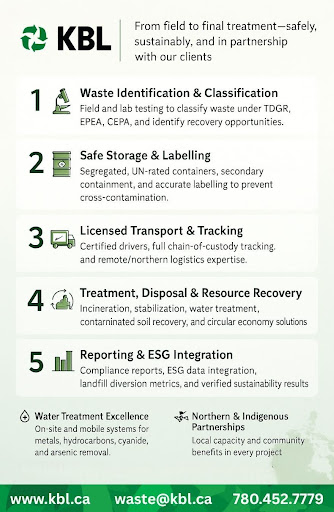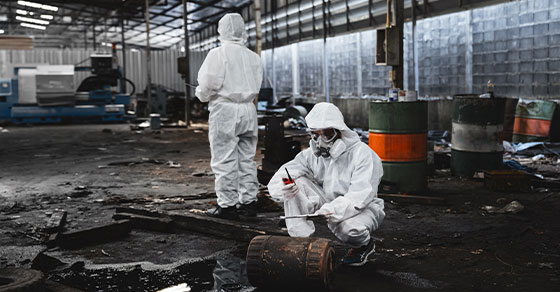Did you know Canadian industries generate over six million tonnes of hazardous waste every year?
From oil sands and mines to urban construction and industrial plants, hazardous waste is a growing environmental and operational challenge. And mishandling it? That comes with steep costs—regulatory fines, lost contracts, environmental damage, and public trust.
At KBL, we help industry turn these risks into sustainable results. With licensed treatment facilities, mobile services, and a vertically integrated delivery model, we offer safe, cost-effective, and ESG-aligned solutions for hazardous waste management, water treatment, and material recovery.
What is Hazardous Waste?
Hazardous waste refers to materials that pose a risk to people, animals, or the environment—through toxicity, flammability, reactivity, or corrosiveness. Every major industry faces it. In fact, many deal with it every single day:
- Mining industry operations bring up heavy metals, acidic rock, and chemical runoff from deep underground.
- Industrial operations handles lead-based paints, asbestos, fuel residues, and solvent-contaminated debris.
- Energy or Oil and gas often produce oily sludge, drilling fluids, chemical waste, and polychlorinated biphenyls (PCBs). These compounds often stay toxic for years.
In Canada, hazardous waste is divided into strict regulatory classes. Common classes include:
- Class 3: Flammable liquids like solvents and fuels.
- Class 4: Flammable solids, often found in industrial and manufacturing workstations.
- Class 5: Oxidizers that can trigger fires during storage.
- Class 6: Toxic or infectious substances.
- Class 8: Corrosive chemicals that can burn skin or metal.
- PCBs: Industrial chemicals that stay in soil and water for decades.
From mining and oilfield waste to legacy contaminated sites, hazardous materials require a well-defined process for storage, transportation, and treatment.
Why Proper Disposal Matters
Improper handling isn’t just non-compliant—it’s costly and damaging:
- Regulatory penalties: Fines in the millions and suspended operations
- Legal risk: Pollution lawsuits and loss of public procurement eligibility
- Reputation loss: Environmental incidents are highly visible and long remembered
- Environmental impact: Contaminants leach into soil, water, and ecosystems
- Remediation costs: Site restoration can take years and millions in capital
With Canada’s hazardous waste market projected to grow to $1.26 billion by 2030, the message is clear: industry needs better systems to manage risk, reduce waste, and demonstrate accountability.
ESG in Action: From Compliance to Circular Solutions
Today, Environmental, Social, and Governance (ESG) performance goes beyond minimum compliance. Leading companies integrate waste reduction, contamination prevention, and water stewardship into core operations.
KBL helps clients:
- Design preventative waste systems to avoid spills and overflows;
- Integrate hazardous waste metrics into ESG reporting;
- Recover residuals for beneficial reuse, not just landfill; and
- Collaborate with Indigenous communities to support environmental leadership.
KBL’s Vertically Integrated Hazardous Waste Services
We offer full-lifecycle management—from the moment hazardous materials are identified in the field to their final, compliant treatment or reuse. Our integrated approach streamlines operations, ensures regulatory compliance, and reduces environmental impact.
1. Waste Identification and Classification
Accurate classification is the foundation of safe and compliant hazardous waste management.
- Field screening and sampling using tools such as XRF analyzers, PetroFLAG, and PHC test kits for real-time decision-making.
- Laboratory analysis to confirm waste composition, concentration levels, and hazardous properties.
- Determination of applicable regulatory codes under Transportation of Dangerous Goods Regulations (TDGR), Environmental Protection and Enhancement Act (EPEA), Canadian Environmental Protection Act (CEPA), and territorial requirements.
- Identification of potential material recovery or recycling pathways to reduce disposal volumes and costs.
2. Safe Storage and Labelling
Preventing cross-contamination and ensuring worker safety starts with correct containment.
- Segregation by hazard class to prevent incompatible chemical reactions.
- Use of UN-rated containers, lined bins, and spill-proof drums for secure containment.
- On-site spill containment systems such as berms, absorbent pads, and secondary containment trays.
- Comprehensive labelling including hazard class, waste type, generator details, and tracking numbers for manifesting.
- Temporary and long-term storage solutions available at KBL’s licensed transfer facilities, each equipped with spill control systems and secure storage zones.
3. Licensed Transport and Tracking
From mine sites in the Arctic to industrial facilities in urban centres, our transportation network ensures safe, traceable waste movement.
- Certified drivers and vehicles meeting TDGR and provincial/territorial transport regulations.
- End-to-end manifesting and tracking to maintain full chain-of-custody documentation.
- Specialized equipment including vacuum trucks, sealed roll-off bins, and enclosed trailers for sensitive materials.
- Remote and northern logistics expertise, including winter road, barge, and air transport options.
- Backhaul programs to reduce transport costs and minimize greenhouse gas emissions.
4. Treatment and Disposal
The final stage is about more than just disposal—it’s about maximizing safety and sustainability.
- Treatment options include incineration, stabilization, solidification, and neutralization.
- Soil and sludge remediation at KBL’s regional treatment facilities, with the ability to treat contaminated soil for reuse.
- Water treatment systems capable of removing hydrocarbons, metals, and other contaminants to meet discharge standards or enable reuse.
- Recovery and recycling programs for used oil, antifreeze, and other reusable materials.
- Partnerships with licensed treatment, storage, and disposal facilities (TSDFs) across Canada for materials requiring specialized handling, including hydrocarbon, chloride, and saline-impacted materials/fluids,and hazardous ash containment.
- Circular economy approach—wherever possible, we divert materials from landfill into alternative fuel blending or material recovery streams.
5. Reporting and ESG Integration
We don’t just manage hazardous waste—we provide the data and insights clients need to prove compliance, meet stakeholder expectations, and demonstrate environmental leadership.
- Regulatory reporting packages that meet or exceed federal, provincial, and territorial requirements.
- Waste generation audits to identify reduction opportunities and track progress over time.
- Integration of waste and water data into client ESG reports, aligning with GRI, SASB, or custom corporate sustainability frameworks.
- Performance dashboards that show volumes diverted from landfill, emissions reduced through backhauls, and water savings achieved through treatment and reuse.
- Support for third-party verification of sustainability claims to ensure credibility and compliance with greenwashing regulations.
Water Treatment: A Key Part of Hazardous Waste Solutions
Hazardous waste often comes with contaminated water—from mine dewatering, leachate, process water, or stormwater runoff. KBL’s mobile and fixed water treatment units are designed to:
- Remove metals, hydrocarbons, arsenic, cyanide, and suspended solids
- Meet EQC discharge criteria for regulatory compliance
- Provide on-site or off-site filtration and treatment
- Reuse water wherever possible to reduce freshwater demand
Circular Economy in Hazardous Waste
At KBL, we treat waste not just as a liability—but as a potential resource.
Our circular economy strategies include:
- Fuel blending and recovery for select waste streams
- Contaminated soil treatment at regional soil treatment facilities
- Used oil and antifreeze recycling at our Edmonton hub
- Beneficial reuse audits to reduce landfill dependency
Whether it’s turning oily sludge into energy feedstock or finding reuse pathways for non-hazardous components, KBL is helping clients lower both waste volume and cost.
KBL Is Canada’s Trusted Leader in Hazardous Waste Disposal
KBL Environmental owns and operates three licensed transfer facilities, a paint recycling facility and 10 soil treatment facilities designed to protect the environment. Each site includes spill control systems, secure storage, and containment zones. Waste is sorted, stored, and shipped for treatment safely and by class. From contaminated soil and water, Class 3 flammable liquids to PCBs, we handle them all.
Our Environment Projects Division supports full-service solutions. This encompasses the management of spill response, waste site cleanup, site audits, and cost-efficiency reviews.
Every service we provide is rooted in strong ESG values and proven hazardous waste management practices. We also have many accolades to our name. This includes 2025 Canada’s Best Managed Companies and the 2024 EY Canada Entrepreneur of the Year honourable mention for innovation and environmental leadership.
Call us at 780-452-7779, contact us online, or click here to schedule a consultation. Our experts are ready to support industries from start to finish.


